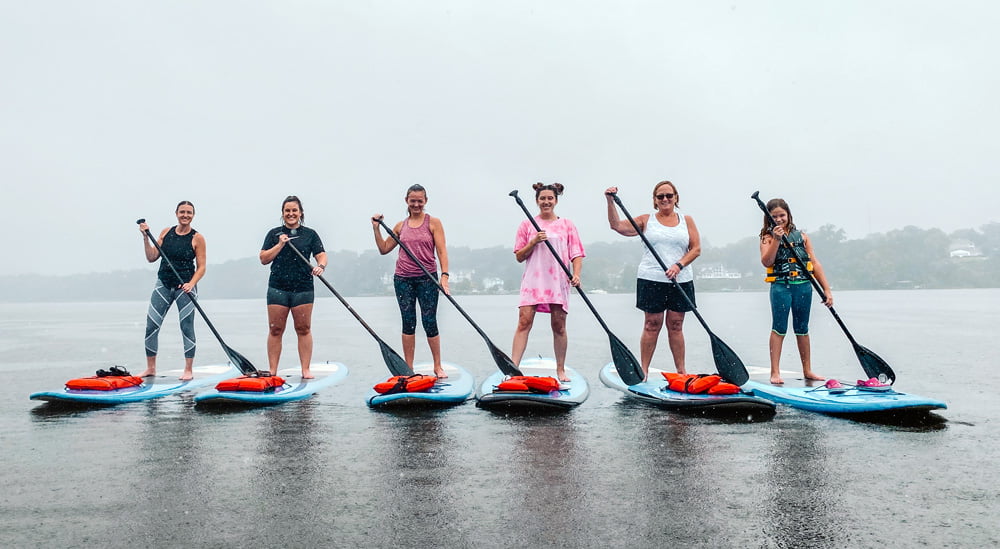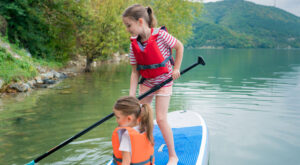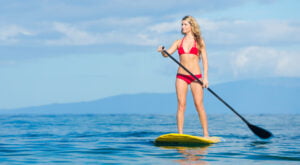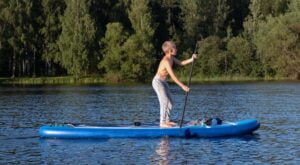Standup paddleboarding, often referred to as SUP, has garnered immense popularity over the past few years. From the sun-soaked beaches of Hawaii to the serene lakes of Finland, you’ll see paddle boarders enjoying this outdoor activity. But what makes it such a global sensation?
The roots of SUP can be traced back to the early Polynesian cultures. Yet, it’s only recently that this sport has captured the world’s attention and curiosity. As paddleboarding continues to trend, it’s fascinating to look at its journey and the factors that contribute to its widespread appeal.
One significant factor in SUP’s popularity is its health benefits. Not only does it offer an exciting way to explore the outdoors, but it also provides a full-body workout. Paddling engages your core, improves balance, and enhances overall fitness. The calmness of gliding over water can also have a therapeutic effect, serving as a mental break from the hustle and bustle of daily life.
Stay with us as we delve deeper into the world of paddle boarding – from its origins to its health benefits and everything you need to know as a beginner.
The Rise and Appeal of Paddle Boarding
The evolution of Stand-Up Paddle boarding has been quite a journey. Originally rooted in the Polynesian culture, it became a mainstream sport in the late 20th century when it hit the shores of Hawaii. It initially served as a practical method for surfboard instructors to manage their large groups of students. Soon, however, the ease and versatility of SUP quickly made it a popular water sport across the globe.
Today, paddle boarding stands tall among the fastest-growing sports worldwide, its appeal resonating with people of all ages and walks of life. The sheer versatility of the sport is one key reason for its universal popularity. Whether you enjoy a serene paddle at sunset, an adventurous surf on the waves, or an intense session of SUP yoga, there is a style for you. It can be practiced on a variety of water bodies – from calm lakes and rivers to the challenging waves of the ocean.
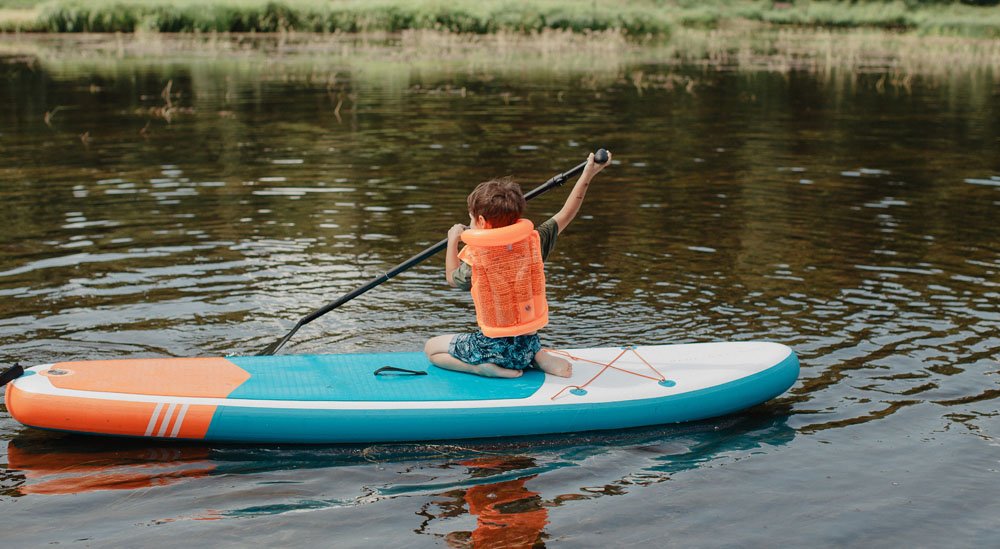
Further fuelling SUP’s popularity is its accessibility. Unlike some other water sports, paddle boarding doesn’t require high levels of physical fitness or skill to start. Beginners can quickly get the hang of it, making it a family-friendly sport that encourages outdoor activity and connection with nature.
The emergence of different types of boards, catering to various paddleboarding activities, has also significantly contributed to the sport’s rise. From inflatable boards for easy storage and transport, to racing boards for speed, there’s a board for every type of paddleboarder.
Let’s explore further in this beginners guide, how this fantastic sport has something to offer everyone, and why its rise is just the beginning of a larger trend.
Health and Fitness Benefits of SUP
Stand Up Paddle Boarding, or SUP, is not just an enjoyable outdoor activity; it’s a fun way to stay fit and healthy. The health benefits are numerous, ranging from physical to mental well-being, making it a comprehensive fitness regime that’s hard to beat.
Physical Health Benefits
SUP is a fantastic full-body workout that engages every major muscle group. From your legs maintaining balance, your core stabilising your body, to your arms and shoulders propelling the paddle, every stroke is a workout. This holistic approach helps improve your strength, endurance, and overall physical fitness.
Cardiovascular health can also be significantly improved with regular SUP sessions. Much like aerobic exercises such as running or cycling, paddle boarding can enhance heart health and reduce the risk of hypertension and heart diseases.
SUP can also aid in improving balance and coordination. The continuous challenge to maintain stability on the board can significantly enhance your motor skills over time.
Mental Health Benefits
But SUP’s benefits aren’t limited to the physical. One of the most substantial gains is the positive impact it has on mental health. Gliding over water, surrounded by nature, provides a serene environment that can help reduce stress and anxiety. It’s a form of moving meditation, promoting mindfulness and a sense of calm.
Additionally, SUP can boost your mood. Like any other physical activity, paddle boarding stimulates the production of endorphins, the body’s natural mood elevators. It’s an uplifting experience that can help combat depression and enhance overall emotional health.
Whether you are seeking a vigorous workout or a peaceful paddle in the outdoors, SUP can cater to your needs, providing the perfect blend of fitness and fun.
Choosing Your SUP Gear as a Beginner
Selecting the right gear is a critical part of your Stand Up Paddle boarding journey. Your SUP board, paddle, and accessories can significantly influence your paddling experience. Here’s a detailed guide to help you make the right choice:
Choosing a SUP Board
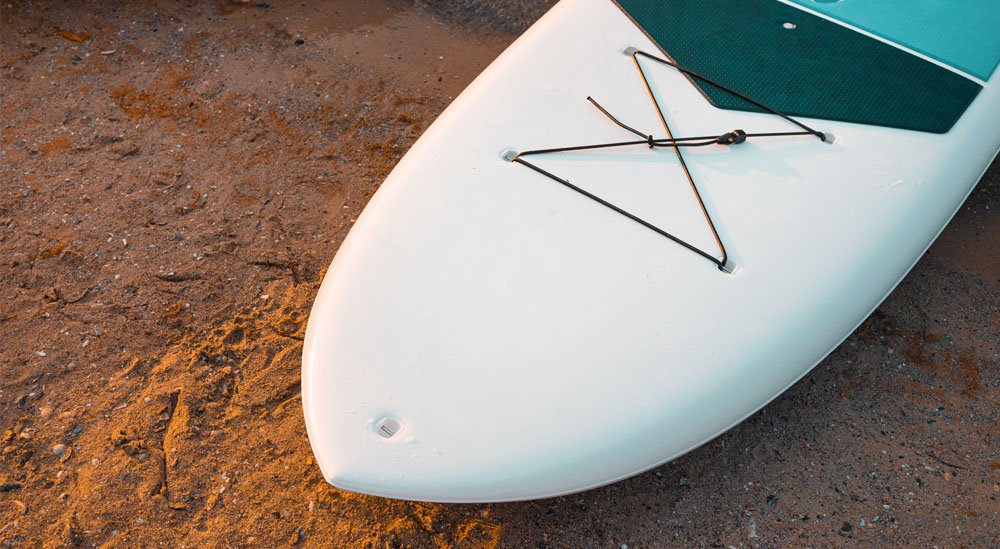
Selecting the right board depends on several factors such as your skill level, body weight, and the type of paddleboarding you plan on doing.
- Beginners often benefit from larger, wider boards that offer more stability.
- Intermediate paddlers might prefer slightly smaller boards that offer better manoeuvrability.
- Advanced paddlers can opt for specialised boards based on their preferred activity, such as racing, surfing, or yoga.
In addition, there are different types of paddle boards like inflatable boards for easy transport and storage, or solid boards for better performance and durability.
Selecting a Paddle
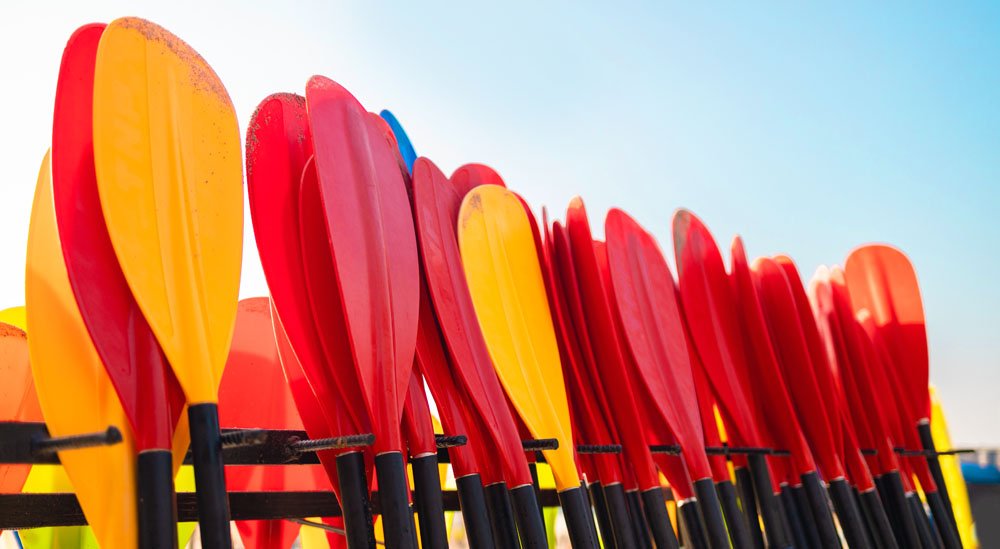
The paddle is your motor in SUP, so it’s essential to pick the right one. Generally, a SUP paddle should be 6 to 10 inches taller than your height. When selecting a paddle, consider:
- Weight: A lighter paddle causes less fatigue.
- Material: Plastic paddles are more durable but heavier, whereas carbon fibre ones are lighter but more expensive.
- Blade size: Larger blades offer more power but require more effort, whereas smaller blades provide less power but are easier to handle.
SUP Accessories
Beyond the board and paddle, you might also need:
- Personal Flotation Device (PFD): In many areas, it’s mandatory to have a PFD on while paddleboarding.
- Leash: A SUP leash tethers your ankle to the board, keeping it close if you fall off.
- Wetsuit or Drysuit: Depending on the weather and water temperature, you might need appropriate clothing.
- SUP Bag: A board bag can protect your board during transportation and storage.
Remember, the right gear can significantly enhance your SUP experience. Take the time to research, try different options, and select the gear that best fits your needs and style of paddleboarding.
Understanding Different Types of SUP
Stand Up Paddle boarding is a versatile sport with different variations tailored for various activities. Depending on your interest and skill level, you might prefer one type of SUP over another. Here are some common variations:
All-Around SUP
As the name suggests, all-around SUPs are designed for a bit of everything. They are great for beginners and are versatile enough for various conditions, from calm lakes to moderate surf.
Surf SUP
These boards are shorter, narrower, and have a curved rocker line to handle waves. They are excellent for surfing but require more skill to maintain stability on flat water.
Touring SUP
Touring SUPs are longer and narrower, designed for efficiency and speed over long distances. They’re great for advanced paddlers looking for a workout or an adventure on the water.
Racing SUP
Much like touring boards, racing SUPs are designed for speed but with an even sleeker, narrower profile. They are built for competition and require a higher skill level to maintain balance.
Yoga SUP
Yoga SUPs are wider and more stable, designed to provide a stable platform for doing yoga on the water. They often come with full-length traction pads for a secure grip during yoga poses.
Inflatable SUP
Inflatable SUPs can be deflated for easy transport and storage. They are generally more durable and cheaper than hardboards but may not perform as well in certain conditions.
Remember, the best board for you depends on your skill level and what you plan on doing. Whether you’re looking for a casual paddle on the lake, an intense surf session, or a peaceful yoga workout, there’s a board out there designed just for you.
Preparing for Your First SUP Experience
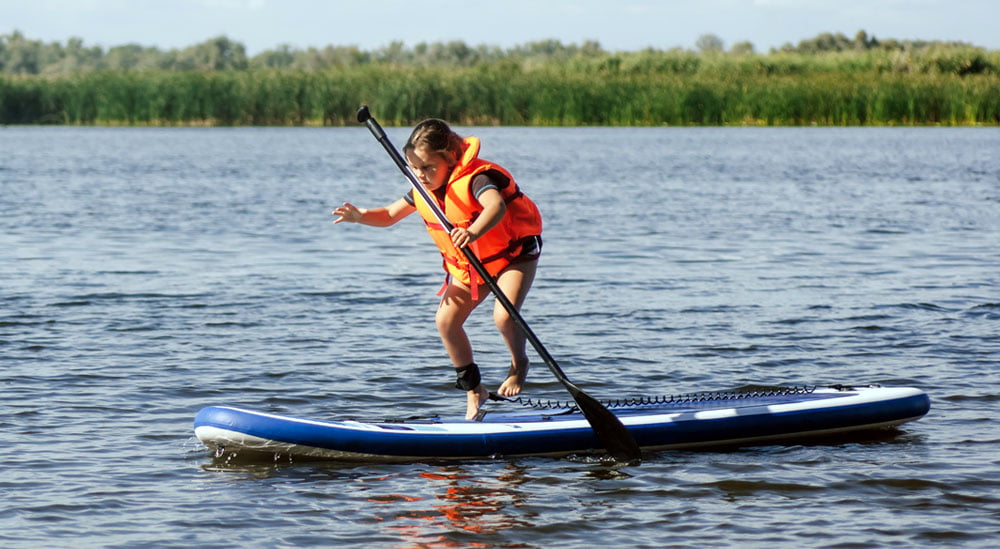
Your first paddle boarding experience can be exciting, but preparation is crucial to ensure a safe and enjoyable time on the water. Here are some steps you should take before setting off on your SUP adventure:
Physical Preparation
Although SUP is a relatively easy sport to pick up, a basic level of fitness will enhance your experience. Engage in light exercises that build strength in your core and upper body, improving your balance and paddle strength.
Check the Weather and Water Conditions
Check the local weather forecast and water conditions before you head out. Calm and warm days are perfect for beginners. Avoid windy conditions and rough waters until you are more confident with your skills.
Water Safety
Understanding water safety is crucial in any water sport. Some key points include:
- Always wear a personal flotation device (PFD).
- Use a leash to ensure your board stays close if you fall off.
- Be aware of local water laws and regulations.
- Learn basic rescue techniques and what to do in case of emergencies.
SUP Gear
Make sure your gear is suitable for your skill level and the conditions you’ll be paddling in. Remember to bring necessary accessories like your PFD, leash, and appropriate clothing.
Get a Lesson or Join a Group
If possible, consider taking a beginner’s lesson or join a SUP group. An experienced instructor can provide valuable tips, ensuring you start off with good techniques, and a group can provide added safety.
Preparing adequately for your first SUP experience will set the foundation for many more enjoyable paddle boarding adventures to come.
SUP Techniques: Basic to Advanced
Mastering paddle boarding involves learning a range of techniques from the very basic to more advanced moves. This guide will take you through the essential SUP techniques you need to know.
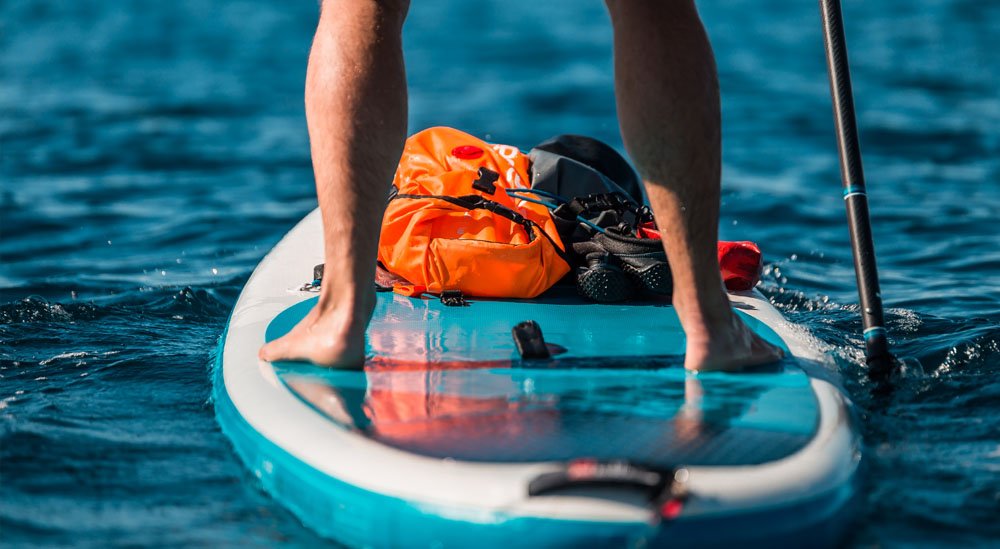
Basic Techniques
Standing Up
The first skill to master in SUP is standing up on your board. Start by kneeling on the board, then stand one foot at a time. Keep your feet parallel and shoulder-width apart, with your knees slightly bent. Many beginners get the urge to want to paddle strait away but once you’re standing, just take a minute to focus on your balance.
Paddling
Paddling correctly is key to moving efficiently on the water. The correct technique is to reach forward with your paddle, submerge the blade fully into the water, and then pull it back towards you.
Turning
The basic turn in SUP is the sweep stroke. To perform a sweep stroke, reach the paddle out wide and then sweep it back towards the tail of the board, this should rotate the board in the opposite direction.
Intermediate Techniques
Paddle Stroke for Speed
To increase your speed, you need to improve your paddle stroke. Try to keep the paddle as straight and close to the board as possible. The more vertical the paddle is during the stroke, the faster you will go.
Cross Bow Stroke
The cross-bow stroke is an excellent technique to turn faster. Reach across the board with your paddle and perform a forward stroke on the opposite side of the board.
Advanced Techniques
Pivot Turn
The pivot turn, also known as a buoy turn, is an advanced turning technique where you step back on the tail of the board, causing the board’s nose to lift out of the water, and then perform a sweep stroke.
Surfing Waves
Once you’re confident with basic and intermediate techniques, you can start to tackle surfing waves. This requires a combination of many skills, including balance, timing, and understanding of how waves work.
Remember, as with any sport, becoming proficient at SUP takes practice. Start with the basics and gradually challenge yourself with more advanced techniques as your confidence and skills grow.
Improving Balance on a Paddle Board
Balancing on a Paddle board can seem intimidating, but with the right techniques and exercises, you’ll be standing upright on your board in no time. Here are some ways to improve your balance:
Body Positioning
Proper body positioning is essential for maintaining balance on a board. Your feet should be shoulder-width apart, centred between the board’s rails (edges). Stand upright with your knees slightly bent.
Weight Distribution
Distribute your weight evenly on both feet over the centre of the board. Leaning too far forward, backward, or to one side can cause you to lose balance and fall into the water.
Gaze Horizon
Keep your gaze on the horizon, not your feet. Looking down can disrupt your balance, while looking forward keeps your posture upright and centred.
Core Stability
SUP is a great workout for your core muscles, which are essential for maintaining balance. Off the board, engage in core-strengthening exercises like planks and sit-ups.
Balance Exercises
Try some balance exercises on your board. Start with shifting your weight from foot to foot, then lifting one foot off the board. Once you’re confident, try more challenging exercises like yoga poses.
Paddle for Stability
Your paddle is a great tool for stability. When you feel unstable, keep your paddle in the water to help regain your balance.
Remember, improving balance takes time and practice. Don’t get discouraged if you fall; it’s part of the learning process. Keep practicing these techniques and exercises, and you’ll see improvements in your balance over time.
Improving Your Skills with Regular Practice
Like any sport, Stand-Up Paddle boarding requires regular practice to improve. Here are some tips for practicing effectively and tracking your progress:
Set a Practice Routine
Create a consistent practice routine. How often you should practice depends on your goals, but a good starting point could be two to three times a week. Consistency is key to progress in paddle boarding for beginners.
Start with Basic Skills
Begin each session by practicing basic skills, such as standing, paddling, and turning. Once you’ve mastered these, you can start working on more advanced techniques.
Challenge Yourself
Always try to push yourself a little further each session. This might mean paddling for a longer time, trying to go faster, or attempting more advanced moves.
Track Your Progress
It’s important to track your progress. You can do this by noting the distance or speed you achieve each session, or by tracking improvements in specific skills.
Get Professional Training
If possible, get some professional training. A qualified instructor can provide valuable feedback and help you improve more quickly.
Join a SUP Community
Joining a local SUP group or online community can be beneficial. You’ll have the opportunity to learn from others, get advice, and find motivation.
Remember, the key to improving in paddle boarding, as with any sport, is persistence. Even when progress seems slow, don’t get discouraged. Keep practicing, and you’ll continue to improve.
Taking Care of Your Gear
Proper maintenance and care of your gear not only extends its lifespan but also ensures your safety while on the water. Here are some tips on cleaning, storing, and repairing your gear:
Cleaning Your SUP Gear
After each use, rinse your board, paddle, and any other gear with fresh water. This is particularly crucial if you’ve been paddling in salt water, which can corrode and damage your equipment over time. Dry everything thoroughly before storing.
Storing Your SUP Gear
Store your gear in a cool, dry place, away from direct sunlight, as UV rays can cause damage. When storing your board, it’s best to keep it on a rack horizontally or vertically against a wall. If neither option is available, you can also store it on its rail (edge) as a last resort.
Repairing Your SUP Gear
Regularly check your gear for any damage. If you notice any dings or cracks in your board, it’s essential to repair them promptly to prevent water seepage and further damage. Minor dings can be repaired using a repair kit, but for more severe damage, it’s best to seek professional help.
Gear Longevity
Prolong the life of your gear by using a board bag for protection, not dragging your board across abrasive surfaces, and being mindful not to hit your paddle against hard objects.
Remember, taking care of your gear involves regular cleaning, proper storage, and timely repairs. These simple maintenance tips will keep your gear in top condition, enhancing your paddle boarding experience.
Tips for Becoming a Pro at Paddle Boarding
Becoming a pro at paddle boarding doesn’t happen overnight, but with some dedication and by following these tips, you can certainly get there:
Observe Other Paddlers
You can learn a lot by watching more experienced paddlers. Notice how they balance, move their bodies, and handle the paddle. You can even record videos to observe later.
Join a Paddle Boarding Club
Joining a paddle boarding club can greatly speed up your progress. You’ll have the opportunity to learn from experienced paddlers, receive constructive feedback, and practice in a safe and supportive environment.
Attend SUP Events
Attending events can be both fun and educational. You’ll get to watch professional paddle boarders in action, learn about the latest gear and trends, and meet like-minded people.
Get Professional Training
Consider getting professional training if you’re serious about becoming a pro. A qualified instructor can provide the knowledge, techniques, and training routines you need to reach a higher level of competence.
Master Different Styles
A true pro can handle different styles, such as racing, surfing and yoga. Each style requires different skills, so mastering multiple styles will make you a more versatile and skilled paddler.
Train Regularly
Regular and consistent training is a must. Make a training schedule that suits your lifestyle and stick to it. Regular practice, coupled with a desire to improve, is the key to becoming a pro.
Take Care of Your Health
Being in good physical condition is essential for SUP. Follow a balanced diet, ensure you get enough rest, and incorporate some cross-training, like yoga or weight lifting, into your fitness routine.
Remember, becoming a pro at paddle boarding is not just about skills; it’s also about attitude. Always have a positive attitude, be open to learning, and, most importantly, have fun.
Safety Measures when Paddle Boarding
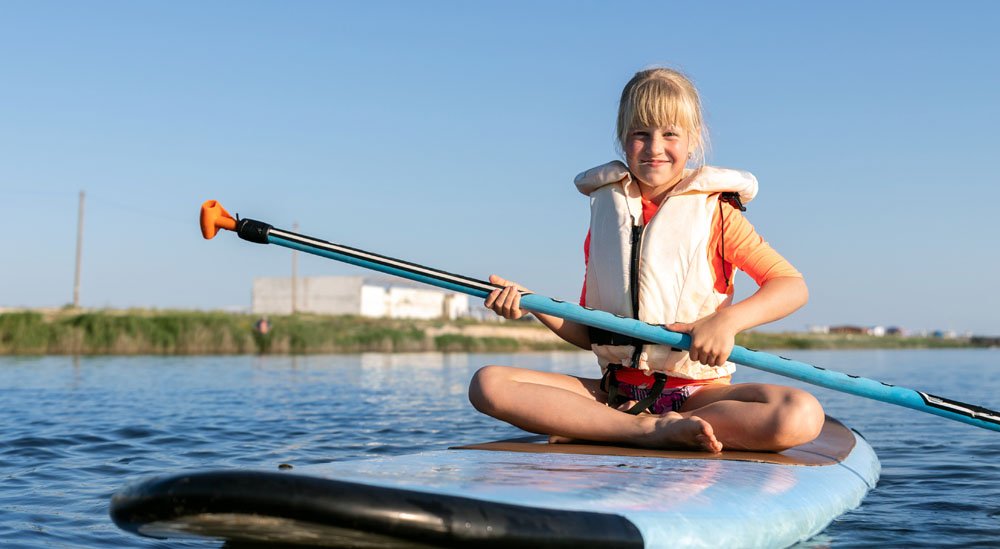
Paddle boarding is a fun and enjoyable activity, but it’s important to always keep safety at the forefront of your mind. Here are some essential safety measures you should always follow:
Wear a Life Jacket
Regardless of your swimming ability, always wear a life jacket when you’re SUPing. Accidents can happen, and a life jacket can be a lifesaver in an unexpected situation.
Use a Leash
A leash attaches you (around your ankle) to your board and prevents you from getting separated from it if you fall off. This is particularly important if you’re paddling in open water or if the current is strong.
Protect Yourself from the Sun
Sun protection is crucial when you’re out on the water. Always wear sunscreen, sunglasses, and a hat, and consider wearing protective clothing.
Understand Weather and Water Conditions
Before heading out, check the weather forecast and be aware of the water conditions. Wind, tide, and current can greatly affect your experience. If the conditions seem challenging and beyond your skill level, don’t risk it.
Carry a Whistle
It’s advisable to carry a whistle when you’re SUPing. This can be used to signal for help in case of an emergency.
Take a Safety Course
A safety course can provide valuable information and training on how to handle different situations and emergencies. This can make you feel more confident and safe when you’re out on the water.
Safety should never be compromised when it comes to paddle boarding. Always follow these measures to ensure you have a safe and enjoyable experience.
Final Thoughts
Stand-up paddle boarding is an incredibly rewarding sport, providing numerous health benefits while allowing you to enjoy the beauty of nature. As we’ve covered in this comprehensive guide, mastering SUP involves learning different techniques, choosing the right gear, understanding safety measures, and most importantly, practicing regularly.
From the basic paddling techniques to more advanced moves, paddle boarding offers something for everyone, regardless of their skill level. Along with mastering these techniques, ensuring your safety by wearing a life jacket, understanding weather conditions, and taking care of your gear are also paramount.
Whether you’re looking to improve your fitness, find a new hobby, or challenge yourself with a new sport, SUP may just be what you’re looking for. So, why not start your journey today? With the right attitude, dedication, and our comprehensive guide, you’ll be gliding across the water in no time!
Remember, everyone starts as a beginner, and with every paddle stroke, you’re one step closer to becoming a pro at paddle boarding. So embrace the process, enjoy the ride, and most importantly, have fun!
